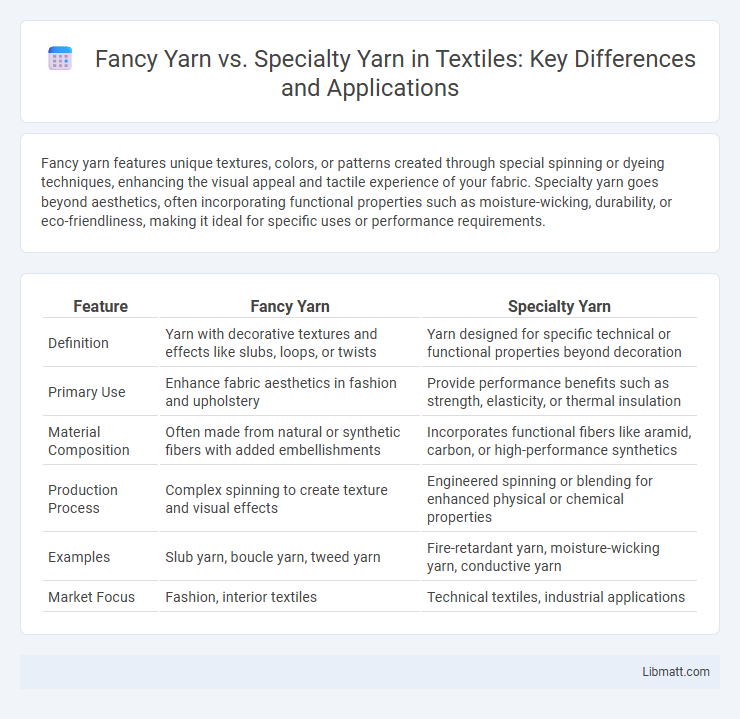Fancy yarn features unique textures, colors, or patterns created through special spinning or dyeing techniques, enhancing the visual appeal and tactile experience of your fabric. Specialty yarn goes beyond aesthetics, often incorporating functional properties such as moisture-wicking, durability, or eco-friendliness, making it ideal for specific uses or performance requirements.
Table of Comparison
| Feature | Fancy Yarn | Specialty Yarn |
|---|---|---|
| Definition | Yarn with decorative textures and effects like slubs, loops, or twists | Yarn designed for specific technical or functional properties beyond decoration |
| Primary Use | Enhance fabric aesthetics in fashion and upholstery | Provide performance benefits such as strength, elasticity, or thermal insulation |
| Material Composition | Often made from natural or synthetic fibers with added embellishments | Incorporates functional fibers like aramid, carbon, or high-performance synthetics |
| Production Process | Complex spinning to create texture and visual effects | Engineered spinning or blending for enhanced physical or chemical properties |
| Examples | Slub yarn, boucle yarn, tweed yarn | Fire-retardant yarn, moisture-wicking yarn, conductive yarn |
| Market Focus | Fashion, interior textiles | Technical textiles, industrial applications |
Introduction to Fancy Yarn and Specialty Yarn
Fancy yarn features unique textures, colors, and patterns created through techniques like twisting, slubbing, or adding metallic fibers to enhance fabric aesthetics. Specialty yarn includes functional fibers designed for specific purposes, such as moisture-wicking, flame resistance, or UV protection, often used in performance and technical textiles. Your choice between fancy and specialty yarn depends on whether the emphasis is on decorative appeal or functional performance in the final product.
Defining Fancy Yarn: Characteristics and Uses
Fancy yarn features unique textures, colors, and patterns created through techniques like twisting, looping, and knotting, offering decorative appeal in textiles. It is often used in fashion, upholstery, and accessories to add visual interest and tactile variety. Your projects benefit from fancy yarn's distinctive flair, enhancing both aesthetics and fabric structure.
What is Specialty Yarn? Key Features
Specialty yarn is a type of yarn designed with unique characteristics, materials, or construction techniques to achieve specific effects, such as texture, strength, or aesthetic appeal. Key features include the incorporation of unusual fibers like metallic threads, novelty elements such as boucle or eyelash textures, and enhanced durability or elasticity tailored for particular applications. Unlike fancy yarn, which emphasizes decorative appearance, specialty yarn focuses on functional properties combined with innovative design.
Differences Between Fancy Yarn and Specialty Yarn
Fancy yarn features unique textures, colors, and patterns created through innovative spinning techniques, making it ideal for decorative and fashion-forward designs. Specialty yarn, on the other hand, is crafted with specific functional properties such as durability, moisture-wicking, or fire resistance, suited for technical or performance fabrics. Understanding these differences helps you select the perfect yarn type tailored to your project's aesthetic and functional requirements.
Common Types of Fancy Yarn
Common types of fancy yarn include boucle, slub, chenille, and eyelash yarns, each offering unique textures and visual effects for creative textile projects. Boucle yarn features loops that create a curly, textured surface, while slub yarn has thick and thin sections that add irregular density. Using specialty yarn like chenille, known for its soft, velvety feel, can enhance your garment's tactile appeal, whereas eyelash yarn adds a fringe-like effect perfect for decorative accents.
Popular Types of Specialty Yarn
Popular types of specialty yarn include boucle, chenille, eyelash, and metallic yarns, each offering unique textures and visual effects for creative knitting and weaving projects. Chenille yarn boasts a soft, velvety feel resulting from its tufted pile, while boucle yarn features loops that add a distinctive bumpy texture. Metallic yarns integrate shiny filaments for a sparkling finish, and eyelash yarns have long strands that create a fringed, fuzzy appearance, making these yarns ideal for statement pieces and decorative accents.
Applications in Fashion and Textiles
Fancy yarns, characterized by unique textures and colors, are extensively used in fashion to create visually striking garments and accessories, enhancing fabric aesthetics with effects like boucle, slub, or metallic finishes. Specialty yarns, engineered for specific functional properties such as moisture-wicking, antibacterial, or flame resistance, are crucial in technical textiles and performance wear, offering advanced comfort and protection. The integration of fancy yarns in high-fashion collections contrasts with the pragmatic application of specialty yarns in sportswear, medical textiles, and industrial fabrics, reflecting their distinct roles in the fashion and textile industries.
Advantages and Disadvantages of Each Yarn Type
Fancy yarn offers unique textures and vibrant color variations ideal for adding visual interest to textiles, but it can be more expensive and less durable than standard yarns. Specialty yarn, designed for specific purposes like strength or softness, provides functional benefits but may lack the decorative appeal of fancy yarn. Understanding your project requirements ensures you choose the yarn type that balances aesthetics with performance effectively.
Choosing the Right Yarn: Fancy vs Specialty
Choosing the right yarn involves understanding the unique qualities of fancy yarn and specialty yarn. Fancy yarns feature textured, multicolored, or novelty designs that add visual interest and texture to your projects, making them ideal for decorative accents and statement pieces. Specialty yarns are crafted for specific purposes such as high performance, durability, or unique fiber content, ensuring your final product meets functional needs, so assess your project's requirements to determine which yarn type best suits your creative goals.
Future Trends in Yarn Innovation
Future trends in yarn innovation emphasize sustainable materials, smart fibers, and multifunctional properties, with fancy yarns evolving to include eco-friendly blends and textured effects enhancing garment aesthetics. Specialty yarns are advancing through high-tech developments such as conductive yarns for wearable technology and bio-engineered fibers for performance wear. Understanding these innovations allows you to select yarns that align with both creative expression and cutting-edge functionality.
Fancy yarn vs Specialty yarn Infographic

 libmatt.com
libmatt.com